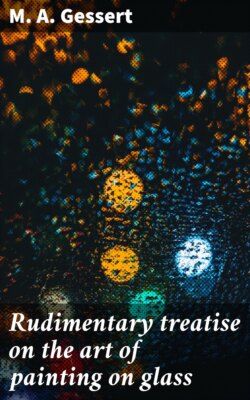Читать книгу Rudimentary treatise on the art of painting on glass - M. A. Gessert - Страница 4
INTRODUCTION.
Оглавление1. The beautiful art of glass-painting is not only restored, in our day, to the perfect fulness of its ancient splendour, but also has acquired, through the giant strides of the science of chemistry, and the great progress latterly made in the arts of design, an amount of technical and æsthetical power, far exceeding whatever could formerly be called to its aid.
Notwithstanding this advantage, however, the art has not yet reached that wide state of diffusion which, from the exquisite effects it is capable of producing, it deserves, and which it attained in the olden time, even with its then more limited capabilities.
2. This circumscribed use of glass-painting can scarcely be accounted for by a comparison of the religious circumstances of our age with those of the past, or on the supposition that this art, confining itself exclusively to exhibition in sacred edifices, had therefore been lost among the frivolous tastes which at present prevail. On the contrary, the works of the finest masters of the art have shown that the wonderful effects of glass-painting may be brought into use for other purposes than the service of the Church, and may be made to satisfy not less the worldly demands of our generation, than the more devotional feelings of the middle ages.
The obstacles which, on the revival of the art, have interposed to check its further extension, and therefore to diminish also the general demand for its productions, are much rather to be attributed to those in whose hands it rests, than to any thing properly belonging to itself; they originate, in fact, less in the art than with the artists.
3. One of the principal causes of the earlier decay of glass-painting was, that its rules being based so entirely upon empirical principles, those who practised it were accustomed to consider the knowledge they had acquired in the thorny path of tedious and long-continued experiment, as their most valuable personal property, forming at once the means of their subsistence, and the foundation of their future artistical fame. They therefore not only kept the information they had gained profoundly secret during their lives, but even carried it with them to their graves, in preference to leaving it behind them to be made use of by their scholars.
This easily intelligible, but not on that account the less reprehensible egotism,—this avarice for artistical monopoly, also operates in some measure to damp the speculative ardour of the present day, and constitutes, in fact, the primitive cause of the evil of which we complain.
On the other hand, the most conducive element towards the full and free development of power generally, and particularly of artistical talent, is competition. It multiplies production, invites public judgment and comparison, and calls forth a laudable emulation, tending, in return, not only to promote the excellence of the works produced, but, by aiming at popularity, also to create an ever new demand for their increase and multiplication.
4. The directions which form the principal part of the following pages have already been published at different times, in earlier communications of the same author scattered through German scientific periodicals, but have now been collected, enlarged, improved, and remodelled into the present form, in the hope that their more general circulation may put into the possession of the many that information which was formerly jealously guarded by the initiated few, and thereby such a general interest may be promoted as cannot fail to be beneficial to the art.
The recipes have been carefully selected, and their correctness and efficacy proved by many years' practice; and it has been endeavoured to make them so easy of comprehension, that neither those unacquainted with chemistry shall fail in their preparation, nor those unpractised in the art go astray in their application.
5. In the classification of the pigments into Fused and Mixed Colours, (understanding by the first all those which are fused into a glaze together with the flux before laid on, and by the second all colouring bodies burnt into the glass without such previous process, whether requiring the help of a flux or not,) the theory given by the Author in his late work on the 'History of Glass Painting' has been adhered to. This division has the advantage of avoiding those errors which had their origin in the early homonymic of flux, for the oxide previously melted with the flux, and for the fluxing medium itself.
It is hoped that these few pages may be the means of prompting, not only artists by profession, but also amateurs, to such an increased and successful exercise of the art, as may tend to show forth its beauties and capabilities to the world in a more general and extended manner than heretofore.
